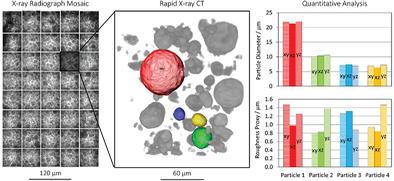Our official English website, www.x-mol.net, welcomes your
feedback! (Note: you will need to create a separate account there.)
Resolving Li-Ion Battery Electrode Particles Using Rapid Lab-Based X-Ray Nano-Computed Tomography for High-Throughput Quantification.
Advanced Science ( IF 14.3 ) Pub Date : 2020-04-30 , DOI: 10.1002/advs.202000362 Thomas M M Heenan 1, 2 , Alice V Llewellyn 1, 2 , Andrew S Leach 1, 2 , Matthew D R Kok 1, 2 , Chun Tan 1, 2 , Rhodri Jervis 1, 2 , Dan J L Brett 1, 2 , Paul R Shearing 1, 2
Advanced Science ( IF 14.3 ) Pub Date : 2020-04-30 , DOI: 10.1002/advs.202000362 Thomas M M Heenan 1, 2 , Alice V Llewellyn 1, 2 , Andrew S Leach 1, 2 , Matthew D R Kok 1, 2 , Chun Tan 1, 2 , Rhodri Jervis 1, 2 , Dan J L Brett 1, 2 , Paul R Shearing 1, 2
Affiliation

|
Vast quantities of powder leave production lines each day, often with strict control measures. For quality checks to provide the most value, they must be capable of screening individual particles in 3D and at high throughput. Conceptually, X‐ray computed tomography (CT) is capable of this; however, achieving lab‐based reconstructions of individual particles has, until now, relied upon scan‐times on the order of tens of hours, or even days, and although synchrotron facilities are potentially capable of faster scanning times, availability is limited, making in‐line product analysis impractical. This work describes a preparation method and high‐throughput scanning procedure for the 3D characterization of powder samples in minutes using nano‐CT by full‐filed transmission X‐ray microscopy with zone‐plate focusing optics. This is demonstrated on various particle morphologies from two next‐generation lithium‐ion battery cathodes: LiNi0.8Mn0.1Co0.1O2 and LiNi0.6Mn0.2Co0.2O2; namely, NMC811 and NMC622. Internal voids are detected which limit energy density and promote degradation, potentially impacting commercial application such as the drivable range of an electric vehicle.
中文翻译:

使用基于实验室的快速 X 射线纳米计算机断层扫描技术解析锂离子电池电极颗粒,实现高通量定量。
每天都会有大量粉末离开生产线,并且通常采取严格的控制措施。为了使质量检查发挥最大价值,他们必须能够以 3D 方式高通量筛选单个颗粒。从概念上讲,X 射线计算机断层扫描 (CT) 能够做到这一点;然而,到目前为止,实现基于实验室的单个粒子的重建依赖于数十小时甚至几天的扫描时间,尽管同步加速器设施有可能具有更快的扫描时间,但可用性有限,使得‐生产线产品分析不切实际。这项工作描述了一种制备方法和高通量扫描程序,使用纳米 CT 通过带波带板聚焦光学器件的全视野透射 X 射线显微镜在几分钟内对粉末样品进行 3D 表征。这在两种下一代锂离子电池正极的各种颗粒形貌上得到了证明:LiNi 0.8 Mn 0.1 Co 0.1 O 2和 LiNi 0.6 Mn 0.2 Co 0.2 O 2 ;即NMC811和NMC622。检测到的内部空隙限制了能量密度并促进退化,可能影响商业应用,例如电动汽车的行驶里程。
更新日期:2020-06-24
中文翻译:

使用基于实验室的快速 X 射线纳米计算机断层扫描技术解析锂离子电池电极颗粒,实现高通量定量。
每天都会有大量粉末离开生产线,并且通常采取严格的控制措施。为了使质量检查发挥最大价值,他们必须能够以 3D 方式高通量筛选单个颗粒。从概念上讲,X 射线计算机断层扫描 (CT) 能够做到这一点;然而,到目前为止,实现基于实验室的单个粒子的重建依赖于数十小时甚至几天的扫描时间,尽管同步加速器设施有可能具有更快的扫描时间,但可用性有限,使得‐生产线产品分析不切实际。这项工作描述了一种制备方法和高通量扫描程序,使用纳米 CT 通过带波带板聚焦光学器件的全视野透射 X 射线显微镜在几分钟内对粉末样品进行 3D 表征。这在两种下一代锂离子电池正极的各种颗粒形貌上得到了证明:LiNi 0.8 Mn 0.1 Co 0.1 O 2和 LiNi 0.6 Mn 0.2 Co 0.2 O 2 ;即NMC811和NMC622。检测到的内部空隙限制了能量密度并促进退化,可能影响商业应用,例如电动汽车的行驶里程。











































 京公网安备 11010802027423号
京公网安备 11010802027423号